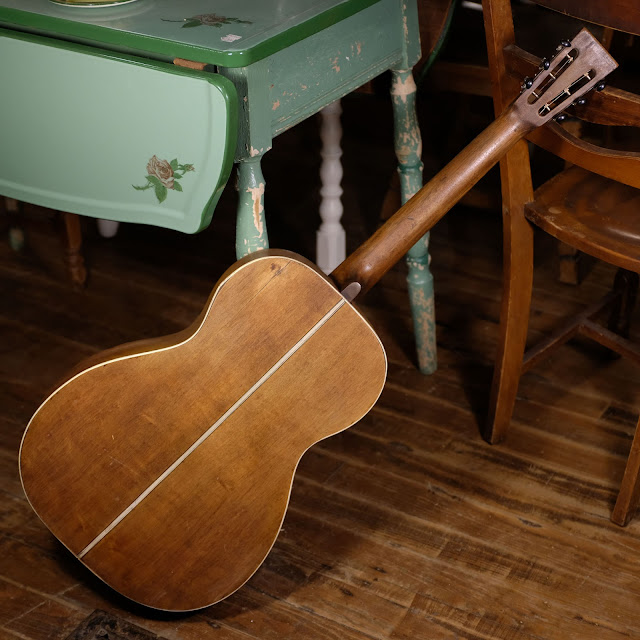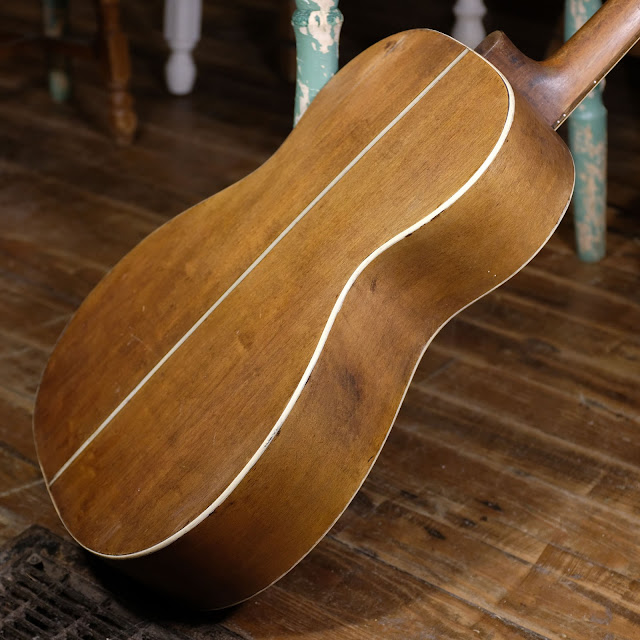1920s Cerrito-made Beltone 000-Size 12-Fret Guitar
This guitar has all the hallmarks of the Oscar Schmidt-related "New York Italian Guild Luthier" Cerrito -- tenon joint, big old 000 12-fret body, and long 26 1/8" scale. For reference, check out this guitar and this guitar -- both of which are very much the same but with mahogany back/sides rather than the birch like on this one.
When you have it in your lap, you actually realize how large it is. The body is just as long as a J-45 and only an inch narrower at 15" on the lower bout. It has 4" depth at the endblock and, as stated, the 26 1/8" scale means it has a longer neck and a more modern proportions. A wide 1 3/4" nut and big, C-shaped neck profile cement it in the old-school, however -- this is clearly a guitar well-suited to fingerpicking territory.
The top is spruce, the neck is mahogany, the bridge is ebony, the fretboard is stained maple, and the back and sides are birch -- all solid. It's ladder-braced and done-so with fairly tall braces. The back is ladder-braced, too. Tonally, it has that crisp, open, bright sound that some Larsons have and it really does push sound forward in the same way as a good Oscar Schmidt blues-box. I have it strung with 50w-11 strings for standard pitch because of the long scale and unreinforced neck, but I can't help but think that with a set of 56w-13 strings and tuned down to C or C# it would be perfect and the heavier mass of bigger gauges would give the top some extra bass oomph.
I put a lot of work into this one. It got a neck reset (and double-bolt reinforcement at the neckblock on the inside as I don't trust tenon joints 100%), a fret level/dress, multiple crack cleat/fill/repair jobs to the top (two long ones and three short ones -- these guitars always have top cracks), minor crack cleating to the back, seam reglue/repairs to the back and top edges, a bridge reglue and conversion to a compensated saddle slot, brace replacement on the back (three were missing and I installed new "strapping brace" back braces in their place), a "popsicle brace" addition under the fretboard extension, and a good setup.
It plays perfectly with 3/32" EA and 1/16" DGBE action at the 12th fret. The neck is straight and the frets have good life left in them. The only playability issue is that I didn't wedge the fretboard extension post-reset and so it dips down over the body.
I'm almost certain this was played Hawaiian-style for almost its entire life as there's a mark at the 1st fret near the nut from where a metal extender nut must've remained for decades. The guitar is also all-original save the replaced braces, vintage parts-bin tuners, new saddle, and new endpin.
I'm almost certain this was played Hawaiian-style for almost its entire life as there's a mark at the 1st fret near the nut from where a metal extender nut must've remained for decades. The guitar is also all-original save the replaced braces, vintage parts-bin tuners, new saddle, and new endpin.
The nut is bone and 1 3/4" in width. The board profile is flat and the back of the neck is a medium-big C-shape.
I love all of the decorative touches on the guitar. All of that purfling/rosette material would've been brightly-colored when new -- bright oranges, reds, yellows, greens, and blues.
The ebony bridge has a very shallow hairline crack across the pins. After removing the bridge from the guitar, I clamped that up, so it's holding-pat. My new saddle-slot is a drop-in style for easy action adjustments. The original slot was uncompensated and so would've played quite out-of-tune up the neck.
As you can see, there's plenty of height to that saddle.
The back and sides are birch and have a couple of old crack repairs on them. I cleated the one on the upper bout that wasn't over kerfing on the inside.
The tuners are parts-in, 1930s parts that I re-buttoned and put on. They work just fine.
These Cerrito-made guitars are very close to Oscar Schmidt (Stella/Sovereign) products in their choice of detailing and design elements.
Here's a detail shot of some of the back seams -- you can see how they're not perfect and have fill to make-up for old repair blunders. They're "all pat," though.
Here's the new ebony endpin.
The top had some schlopped-on paint which wrote "JO." When I removed it, there were gouges in the top under it. They're not totally obvious, but they're there.
Here's how it looks in different light.
Here you can see one of my three replacement "strapping" braces on the back. This is top material used to make a brace. I've seen this on some old Vega and Weymann guitars and it's a stop-gap measure that works well to replace missing braces on less-expensive guitars as I don't have to remove the back from the guitar to install them well.
They flex when installed and so conform to the way the back has changed over time without the need for a lot of labor to make perfectly-fitted braces. Once they're glued, they're nice and stiff, too, and actually give the back more resonance than tall braces.
Here you can see a remaining original brace and some cleats for a back crack.




























Comments